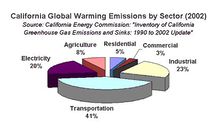Hybrid Electric Vehicle Battery System
Contents
Rationale
- Automobiles are a source of considerable pollution at the global level, including a significant fraction of the total greenhouse gas emissions.
- On July 22, 2002 California Governor Gray Davis signed into law AB 1493 (commonly known as the "Pavley law") — precedent-setting legislation to reduce global warming pollution from motor vehicles.
- This bill directs the California Air Resources Board (CARB) to develop and adopt regulations that achieve the maximum feasible and cost-effective reduction of greenhouse gas emissions (GHG) from passenger cars and light trucks sold in California.
New Developments
The new millennium is bringing a millennial change to the family car. A few years back, the key concerns were:
- Pollution,
- Nagging worries about global warming, and
- Oil shortages.
These concerns led to the development of Electric Vehicle (EV’s) powered by batteries. But current battery technology does not provide EV's with a range that is acceptable to consumers.
Limitations of EV’s:
- An average commute to work is around 40 miles.
- EV's have a range of 80-100 miles using advanced battery technology.
- While batteries need frequent recharging, they are not the only way to power an electric car.
Hybrid Electric Vehicle (HEV)
The Hybrid Electric Vehicle (HEV) is just the first step in reducing the environmental impacts of automobile use without losing comfort, performance, storage room and extended driving range.
Advantages of HEV’s:
- The HEV contains parts of both gasoline and electric vehicles in an attempt to get the best of both worlds.
- It is able to operate nearly twice as efficiently as traditional internal combustion vehicles.
- It has equivalent power, range, cost and safety of a conventional vehicle while reducing fuel costs and harmful emissions.
- The battery is continuously recharged by a motor/generator driven by the Internal Combustion Engine (ICE) or by regenerative braking.
Components of the HEV Battery System
The battery in an HEV is the energy storage device for the electric motor. Unlike the gasoline in the fuel tank, which can only power the gasoline engine, the electric motor in a hybrid car can put energy into the battery as well as draw energy from it.
- Battery: Two or more electrochemical energy cells connected together to provide electrical energy.
- Generator: The generator is similar to an electric motor, but it acts only to produce electrical power.
- Electric motor: Advanced electronics allow it to act as a motor as well as a generator. For example, when it needs to, it can draw energy from the batteries to accelerate the car. But acting as a generator, it can slow the car down and return energy to the batteries.
- SOC: The State of Charge of a battery is its available capacity expressed as a percentage of its rated capacity.
HEV battery system design parameters
Factors affecting battery performance:
- Temperature: Battery performance is highly dependent on temperature. Each type of battery works best within a limited range of temperatures.
- Battery age/Shelf life: Corrosion is the main culprit behind decreased performance in lead acid type batteries with age.
- Depth of discharge: Batteries are able to maintain their performance longer when they are not deeply discharged regularly.
Design parameters:
- How much space is available for the batteries?
- How much can they weigh?
- What is the desired range?
- What is the weight of the vehicle?
- What is the targeted vehicle cost?
- How will the batteries be recharged and
- What kind of drive system requirements is needed?
These are necessary questions because of the variety of battery types available and the differences between them. The chart below lists the characteristics of the most common types of batteries. (Source [1])
